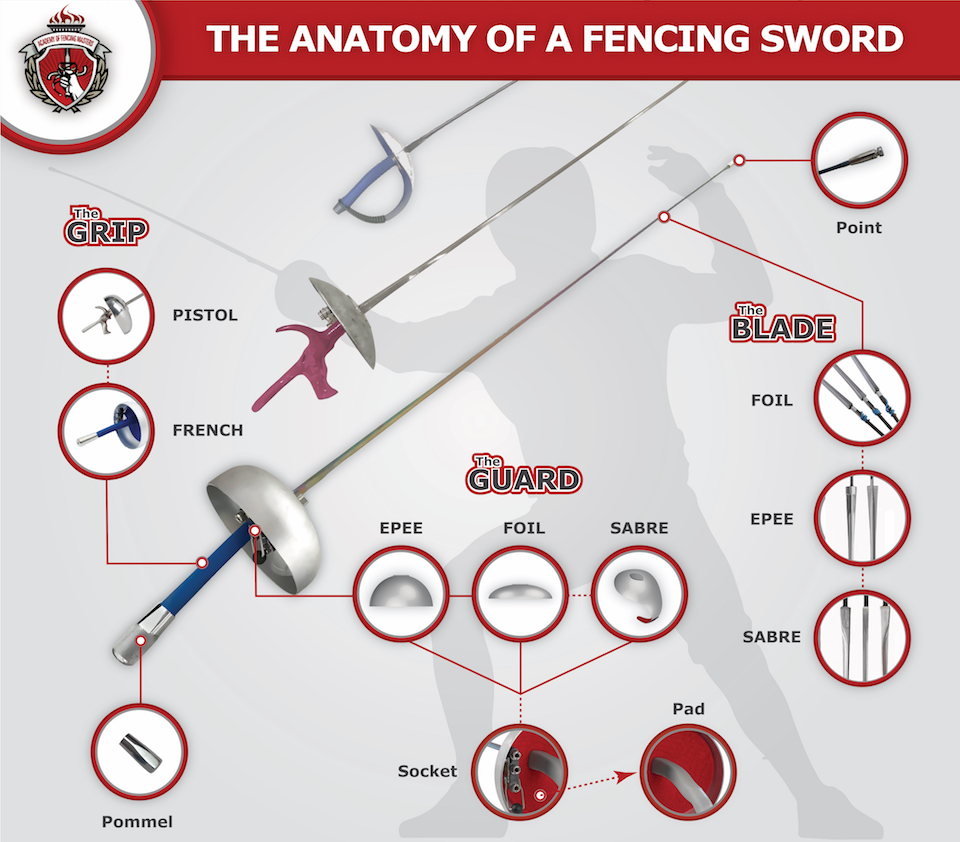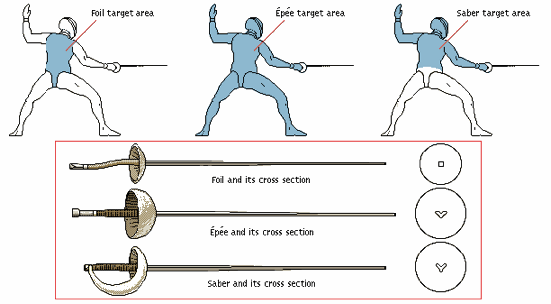In the captivating world of fencing, a discipline that intertwines skill, strategy, and speed, the Olympic Games showcase the pinnacle of competitive excellence. Among the various events, the choice of fencing blade plays a pivotal role in determining the outcome of each match. The Olympic fencing competitions feature three distinct types of blades, each with its unique characteristics and requirements. This article delves into the world of fencing, exploring the different blades used in the Olympic games, their history, and the intricacies of each weapon.
Exploring the Different Fencing Blades in the Olympics
Fencing, an ancient art of combat, has evolved into a sophisticated sport with a rich history in the Olympic Games. It involves three distinct weapons: the foil, the epee, and the sabre, each with its unique characteristics and rules. In this article, we will delve into the specifics of these fencing blades, exploring their designs, techniques, and strategic applications in Olympic competitions.
The Foil
The foil, the lightest of the three fencing blades, is a descendant of the 18th-century small sword. It is a flexible, rectangular blade with a blunt tip, typically made of steel or carbon fibre. The foil is used in a point-scoring system where competitors aim to hit their opponent’s torso, including the back, but excluding the arms and legs. The foil’s flexibility allows for quick, precise movements and rapid-fire attacks, making it an ideal weapon for agile and tactical fencers.
The Epee
The epee, also known as the duelling sword, is the heaviest and sturdiest of the fencing blades. It features a triangular or hexagonal cross-section and a blunted point. Unlike the foil, the entire body of the opponent is a valid target in epee fencing, including the head and arms. This weapon requires strength, endurance, and tactical prowess, as fencers must use their entire body to wield the epee effectively.
The Sabre
The sabre, inspired by the cavalry sabres of Central European origin, is characterised by its curved, single-edged blade and knuckle guard. It is designed for cutting and slashing, rather than thrusting. In sabre fencing, the head, arms, and torso (excluding the hands) are valid targets. The sabre demands speed, agility, and aggressive tactics, making it a thrilling event to watch in the Olympics.
Blade Design and Material
Fencing blades are meticulously crafted to meet specific regulations and enhance performance. They are typically made from high-carbon steel or advanced materials like titanium and vanadium. The design of each blade is tailored to its intended use, with the foil being the most flexible and the epee the sturdiest. The sabre, with its curved edge, requires a unique balance between strength and agility.
Techniques and Strategies
Each fencing blade demands distinct techniques and strategies. Foil fencing focuses on speed, agility, and precision, with an emphasis on quick footwork and clever blade manipulation. Epee fencing, on the other hand, involves more forceful movements and tactical positioning, requiring fencers to use their entire body to control the weapon. Sabre fencing combines the agility of foil with the power of epee, demanding both quick reflexes and strong cutting motions.
Evolution of Fencing Blades
Throughout history, fencing blades have evolved significantly, from their origins as functional weapons to the highly specialized sporting equipment we see today. Advances in technology have led to lighter, stronger, and more durable materials, allowing fencers to perform increasingly complex maneuvers with greater precision and speed. The development of fencing blades reflects not only improvements in material science but also the continuous refinement of fencing techniques and strategies.
| Weapon | Design | Techniques | Valid Targets |
|---|---|---|---|
| Foil | Flexible, rectangular blade with blunt tip | Speed, agility, precision | Torso, including back, excluding arms and legs |
| Epee | Triangular or hexagonal cross-section, blunted point | Strength, endurance, tactical prowess | Entire body, including head and arms |
| Sabre | Curved, single-edged blade with knuckle guard | Speed, agility, aggressive tactics | Head, arms, and torso, excluding hands |
What blades do Olympic fencers use?
Olympic fencers use three types of weapons: foil, epee, and sabre. Each weapon has a unique blade design and functionality.
1. Foil
The foil is a lightweight weapon with a small, blunt blade that is used to score points by hitting the opponent’s chest. The blade is usually made of steel and has a rectangular or triangular cross-section. The length of the blade can vary, but it is typically around 35 inches (89 cm) long. The foil blade is not sharp and has a blunted point to prevent injury.
2. Epee
The epee is a heavier weapon than the foil, with a stiffer blade and a larger bell guard. The blade of an epee is typically triangular in cross-section and is usually around 37 inches (94 cm) long. Unlike the foil, the epee has a sharp point, but it is still blunted to prevent serious injury. The epee is used to score points by hitting any part of the opponent’s body.
3. Sabre
The sabre is a curved weapon with a single-edged blade. It is used to score points by hitting the opponent’s upper body, including the head, arms, and torso. The blade of a sabre is usually around 32 inches (81 cm) long and has a curved, single-edged design. The sabre blade is not sharp and has a blunted point for safety reasons.
What are the different types of fencing blades?
Fencing is a diverse sport with a rich history, and its equipment, particularly the fencing blades, have evolved over time. There are several types of fencing blades, each designed for a specific fencing discipline. These blades vary in terms of their shape, size, weight, and functionality, allowing fencers to adapt their techniques to the specific demands of each discipline.
1. Foil Blade
The foil blade is one of the most common fencing blades used in the sport. It is lightweight, with a rectangular or triangular cross-section, and has a blunt point to prevent injury. Foil fencing emphasizes agility and quick movements, making the foil blade an ideal choice for this discipline. It is typically made of steel or carbon fiber and measures between 90 and 110 cm in length.
- Rectangular or triangular cross-section
- Blunt point to prevent injury
- Lightweight
- Typically made of steel or carbon fiber
- Measures between 90 and 110 cm in length
2. Épée Blade
The épée blade is another popular fencing blade, known for its unique design and functionality. It has a triangular cross-section and a sharp point, which allows fencers to score points by hitting their opponents anywhere on their body, including the mask. Épée fencing focuses on strategy and control, making the épée blade an essential tool for this discipline. Épée blades are typically made of steel and can measure up to 110 cm in length.
- Triangular cross-section
- Sharp point
- Allows scoring points anywhere on the body
- Typically made of steel
- Can measure up to 110 cm in length
3. Sabre Blade
The sabre blade is a curved, single-edged fencing blade, similar to a scimitar or a cavalry sabre. It has a flattened, curved blade with a single cutting edge and a pointed tip. Sabre fencing emphasizes powerful, slashing attacks, making the sabre blade a crucial part of this discipline. Sabre blades are typically made of steel and can measure up to 105 cm in length.
- Curved, single-edged blade
- Flattened, curved shape
- Single cutting edge
- Pointed tip
- Typically made of steel
- Can measure up to 105 cm in length
What are the different types of Olympic fencing?
Introduction to Olympic Fencing
Olympic fencing is a competitive sport that involves three types of fencing: foil, épée, and sabre. Each type has its own unique rules, equipment, and techniques. Fencing is one of the oldest sports featured in the Olympic Games, dating back to the inaugural Athens 1896 Olympics.
Foil Fencing
Foil fencing is one of the most technical forms of fencing. The foil is a lightweight weapon with a blunted tip, which scores points by hitting an opponent’s valid target area – the torso, back, and head. Foil fencing emphasizes agility, quick reflexes, and precise movements. Points are awarded when the tip of the foil hits the opponent’s valid target area.
- Equipment: Foil, fencing jacket, mask, gloves, and breeches.
- Valid Target Area: Torso, back, and head.
- Techniques: Foil fencing involves a lot of footwork, feints, and compound attacks.
Epee Fencing
Epee fencing is considered the most aggressive form of fencing. The épée is a heavier weapon than the foil, with a stiffer blade and a larger bell guard. It allows fencers to attack anywhere on their opponent’s body, including the head, and there is no off-target area. Épée fencing focuses on powerful, precise attacks and strategic defense.
- Equipment: Épée, fencing jacket, mask, gloves, and breeches.
- Valid Target Area: Entire body.
- Techniques: Épée fencing involves powerful attacks, strategic defense, and clever use of distance.
Sabre Fencing
Sabre fencing is the most aggressive and dynamic form of fencing. The sabre is a curved weapon with a single edge and a curved end. It allows fencers to score points by hitting their opponent’s upper body, including the head. Sabre fencing emphasizes speed, agility, and powerful cutting actions.
- Equipment: Sabre, fencing jacket, mask, gloves, and breeches.
- Valid Target Area: Upper body, including the head.
- Techniques: Sabre fencing involves quick footwork, aggressive attacks, and clever use of angles.
What is the difference between foil saber and epee?
The primary difference between foil, saber, and epee fencing lies in the weapon used and the scoring method employed. All three weapons have different characteristics and target areas, requiring distinct fencing techniques and strategies.
Weapon Characteristics
Foil, saber, and epee each have unique characteristics that set them apart from one another. The foil has a light, flexible blade with a blunt tip and a small, circular guard. The saber has a curved, single-edged blade with a sharp point and a knucklebow-style guard. The epee is the heaviest weapon, featuring a stiff, triangular blade with a sharp point and a large, circular guard. These differences in design directly impact the fencing techniques and strategies employed.
Target Areas
The target areas for each weapon vary significantly. In foil fencing, valid targets include the entire torso, from the shoulders to the groin, both front and back. In saber fencing, the target area includes the entire body above the waist, excluding the hands. In epee fencing, the entire body is a valid target, including the head, hands, and feet. These differences in target areas necessitate distinct fencing strategies and techniques.
Scoring Methods
The scoring methods for foil, saber, and epee also differ. In foil fencing, points are awarded when the tip of the blade hits the opponent’s valid target area. In saber fencing, points can be scored with the blade’s edge or point. In epee fencing, points are awarded for hits anywhere on the opponent, regardless of whether the blade’s edge or point makes contact. These differences in scoring methods require fencers to adopt unique strategies and techniques for each weapon.
Frequently Asked Questions
What are the three types of fencing blades used in the Olympics?
The Olympic fencing competition features three distinct types of fencing blades, each with its own unique characteristics and techniques. These are the foil, the epee, and the saber. The foil is a lightweight weapon with a blunt tip, used for thrusting attacks. It targets the torso, including the back, but not the arms or legs. The epee, on the other hand, is a heavier weapon with a sharp point, allowing for both thrusting and cutting attacks. It is the only fencing weapon that allows simultaneous scoring, meaning both fencers can score a point against each other at the same time. Lastly, the saber is a single-edged weapon with a curved blade, used for both cutting and thrusting. It targets the entire body above the waist, excluding the hands. Each blade requires different fencing techniques and strategies, making Olympic fencing a diverse and challenging sport.
What are the main differences between foil and epee fencing blades?
The main differences between foil and epee fencing blades lie in their design, target area, and scoring rules. The foil has a lightweight, rectangular blade with a blunt tip, and its target area includes the torso, back, and head. It operates under a right-of-way scoring system, where the fencer who initiates the attack receives the point if they land a hit. On the other hand, the epee has a heavier, triangular blade with a sharp point, and its target area encompasses the entire body. Epee fencing uses an electric scoring system, where the first fencer to register a hit on their opponent scores a point, regardless of who initiated the attack. This difference in design and scoring rules significantly influences the fencing techniques and strategies employed by athletes specializing in each weapon.</
How does the saber fencing blade differ from the other two types?
The saber fencing blade stands out from the foil and epee due to its unique design and the target area it covers. Unlike the foil and epee, which are primarily used for thrusting attacks, the saber is a single-edged weapon with a curved blade, used for both cutting and thrusting. Its target area includes the entire body above the waist, excluding the hands. Saber fencing also uses an electric scoring system, similar to epee, where the first fencer to register a hit on their opponent scores a point. However, the saber’s curved blade and cutting capability require fencers to employ different techniques, such as circular motions and slashes, which are not seen in foil or epee fencing. This distinctiveness makes saber fencing a highly dynamic and demanding discipline in the Olympic fencing competition.</
What safety measures are taken to ensure the fencing blades are safe for Olympic athletes?
Olympic fencing blades undergo rigorous safety testing to ensure they are safe for athletes to use during competitions. The blades are made of a strong yet flexible material, such as steel or aluminum, which allows them to withstand the impact of a fencing bout without causing injury. The tips of the blades are blunted and rounded to prevent accidental piercing. Additionally, the blades are equipped with an electric button at the tip that triggers a scoring light when pressed, eliminating the need for a sharp point. Fencers also wear protective gear, including masks, gloves, and jackets, to safeguard against any accidental slashes or pokes. The Olympic organizing committee and fencing governing bodies closely monitor the manufacturing and use of fencing blades to guarantee the safety of all participating athletes.
I’ve been working in technology and IT since 1993 and on the Internet as a blogger and webmaster since 2004. I love technology, gadgets, movies and travel. I love researching and writing about technology, travel and cars.


